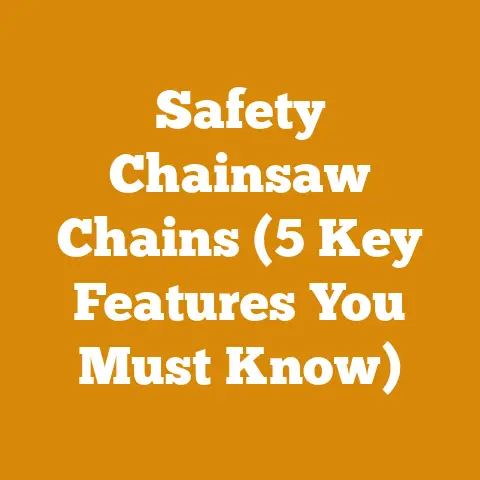Can You Put a Chainsaw Blade on Backwards? (Bar Setup Tips)
WARNING: Attempting to operate a chainsaw with the blade installed backward is extremely dangerous and can result in severe injury or death.
This guide is for informational purposes only to help you understand the risks and ensure correct chainsaw bar and chain setup.
Never operate a chainsaw unless you are properly trained and wearing appropriate safety gear.
Introduction: A Lesson Learned the Hard Way
I’ll never forget the day I almost made a potentially fatal mistake with my chainsaw.
It was early in my firewood-cutting career, and I was rushing to get a load ready before the weather turned.
In my haste, I wasn’t paying close enough attention, and I nearly mounted the chainsaw bar backward.
Luckily, I caught it before starting the saw, but the close call served as a stark reminder: complacency has no place when dealing with powerful tools like chainsaws.
Understanding the Risks: Why Backwards is a Bad Idea
The immediate answer to the question is a resounding NO.
Operating a chainsaw with the blade installed backward is incredibly dangerous.
Here’s why:
- Directional Cutting: Chainsaw chains are designed to cut in one direction only.
The cutting teeth are angled to efficiently slice through wood as the chain moves around the bar in a specific orientation.
If the chain is reversed, the teeth will be facing the wrong way, rendering them ineffective. - Kickback: Kickback is a sudden, forceful upward or backward movement of the chainsaw that can occur when the chain nose contacts a solid object or is pinched in the cut.
A properly installed chain mitigates some of this risk by directing the cutting force downwards.
A backward chain exacerbates the kickback potential, making it far more likely and violent. - Chain Damage: Running a chain backward will quickly dull the cutting teeth.
The non-cutting edges will rub against the wood, generating excessive heat and friction.
This can damage the chain, the bar, and potentially the chainsaw’s drive sprocket. - Physical Injury: The most significant risk is physical injury.
A backward chain will not cut effectively, leading to increased vibration and instability.
The operator is likely to lose control of the saw, resulting in cuts, lacerations, or even more severe injuries.
The Anatomy of a Chainsaw Bar and Chain: A Technical Overview
To understand why proper installation is crucial, let’s delve into the technical aspects of a chainsaw bar and chain.
- The Chainsaw Bar: The chainsaw bar is the guide for the chain.
It’s a laminated steel plate with a groove running around its perimeter.
The chain rides in this groove.- Bar Length: Bar length is measured from the tip of the bar to where it enters the chainsaw body.
Common lengths range from 10 inches to over 36 inches, depending on the saw’s power and intended use.
Choosing the right bar length is crucial for safe and efficient cutting. - Bar Mount: The bar mount is the area where the bar attaches to the chainsaw.
Different chainsaw models have different bar mount patterns.
It’s essential to use a bar that is compatible with your chainsaw. - Sprocket Nose: Some bars have a sprocket nose at the tip.
This reduces friction and wear on the chain, especially when making plunge cuts. - Bar Oil Holes: The bar has oil holes that allow lubricating oil to flow from the chainsaw’s oil reservoir to the chain.
Proper oiling is critical for extending the life of the chain and bar. - Wear Indicators: Many bars have wear indicators that show when the bar is worn and needs to be replaced.
- Bar Length: Bar length is measured from the tip of the bar to where it enters the chainsaw body.
- The Chainsaw Chain: The chainsaw chain is the cutting element.
It’s composed of numerous interconnected parts, including:- Cutting Teeth (Cutters): These are the sharp, angled teeth that do the actual cutting.
They are typically made of hardened steel.- Tooth Geometry: The geometry of the cutting teeth is critical for efficient cutting.
Different tooth designs are optimized for different types of wood and cutting conditions.
Common types include chisel, semi-chisel, and chipper teeth. - Raker Depth: The raker, also known as the depth gauge, controls how much the cutting tooth bites into the wood.
The raker depth must be properly set for efficient cutting.
Too much raker depth can cause the saw to grab or kickback, while too little raker depth will result in slow cutting.
- Tooth Geometry: The geometry of the cutting teeth is critical for efficient cutting.
- Tie Straps (Drive Links): These connect the cutting teeth and ride in the groove of the chainsaw bar.
- Drive Link Count: The number of drive links on a chain must match the bar length and sprocket size.
- Gauge: The gauge of the drive links refers to their thickness.
It must match the gauge of the chainsaw bar.
Common gauges include .043″, .050″, .058″, and .063″.
- Connecting Links: These connect the tie straps and provide flexibility to the chain.
- Cutting Teeth (Cutters): These are the sharp, angled teeth that do the actual cutting.
- The Drive Sprocket: The drive sprocket is located on the chainsaw’s engine and engages with the drive links of the chain, propelling it around the bar.
- Sprocket Pitch: The sprocket pitch refers to the distance between the teeth on the sprocket.
It must match the pitch of the chainsaw chain.
Common pitches include .325″, 3/8″, and .404″.
- Sprocket Pitch: The sprocket pitch refers to the distance between the teeth on the sprocket.
Technical Specifications Example:
Step-by-Step Guide to Correct Chainsaw Bar and Chain Installation
Here’s a detailed guide to correctly installing a chainsaw bar and chain:
- Safety First: Before starting any work on your chainsaw, ensure the engine is off and the spark plug wire is disconnected.
Wear gloves to protect your hands from sharp chain teeth. - Remove the Side Cover: Use the appropriate wrench or screwdriver to loosen and remove the side cover that protects the bar and chain.
- Inspect the Bar: Check the bar for wear, damage, and proper lubrication.
Clean the bar groove with a screwdriver or specialized bar groove cleaner.
Ensure the oil holes are clear.
If the bar is worn or damaged, replace it. - Position the Chain: Lay the chain out on a flat surface.
Observe the direction of the cutting teeth.
The teeth should point forward in the direction of chain rotation.
This is crucial! - Place the Chain on the Bar: Starting at the tip of the bar, carefully place the chain around the bar groove, ensuring that the drive links are fully seated in the groove.
The cutting edges of the teeth should be pointing in the direction the chain will travel around the bar. - Mount the Bar and Chain: Position the bar onto the chainsaw, aligning the bar mount with the studs on the saw’s body.
Ensure the tensioning pin (if applicable) is properly aligned with the hole in the bar.
The chain should now be looped around the drive sprocket. - Reinstall the Side Cover: Replace the side cover and tighten the nuts or screws finger-tight.
- Adjust Chain Tension: Use the chain tensioning screw to adjust the chain tension.
The chain should be snug on the bar, but you should still be able to pull it around the bar by hand.
When you pull the chain away from the bar in the middle of the top, you should be able to see about half the drive links.- Tensioning Screw Types: Chainsaws use different mechanisms to tension the chain.
Some have a screw on the side of the chainsaw that pushes the bar forward, while others have a screw built into the side cover. - Temperature Considerations: Chain tension should be adjusted according to the ambient temperature and the type of wood being cut.
A slightly looser chain is preferable when cutting softwoods or in cold weather, while a tighter chain is better for hardwoods or in warm weather.
- Tensioning Screw Types: Chainsaws use different mechanisms to tension the chain.
- Final Tightening: Once the chain tension is properly adjusted, fully tighten the side cover nuts or screws.
- Test the Chain: Before starting the saw, manually rotate the chain around the bar to ensure it moves freely and the tension is correct.
Double-check that the cutting teeth are facing the correct direction. - Start the Saw (Carefully): Start the chainsaw according to the manufacturer’s instructions.
Let the saw idle for a few seconds and observe the chain.
It should rotate smoothly around the bar.
If the chain is not rotating properly or is making unusual noises, stop the saw immediately and recheck the installation.
Visual Aid: Imagine the chain as a bicycle chain.
The cutting teeth are like the pedals; they need to be facing forward to propel you.
Common Mistakes and Troubleshooting
Even with careful installation, problems can sometimes arise.
Here are some common mistakes and how to troubleshoot them:
- Chain is Too Loose or Too Tight: Improper chain tension is a common issue.
A loose chain can derail from the bar, while a tight chain can cause excessive wear and tear on the bar, chain, and sprocket.
Adjust the chain tension as described above. - Chain is Binding or Sticking: This can be caused by a lack of lubrication, a bent bar, or a dull chain.
Ensure the bar oil reservoir is full and the bar oiler is functioning correctly.
Check the bar for straightness and replace it if necessary.
Sharpen or replace the chain if it is dull. - Chain is Not Cutting Properly: This is usually caused by a dull chain or incorrect raker depth.
Sharpen the chain or have it professionally sharpened.
Check the raker depth and adjust it if necessary. - Chain is Derailing: A chain that frequently derails can be caused by a loose chain, a worn bar, or an incorrectly sized chain.
Ensure the chain tension is correct.
Inspect the bar for wear and replace it if necessary.
Verify that the chain is the correct size for the bar and sprocket. - Bar is Overheating: This is usually caused by a lack of lubrication or a dull chain.
Ensure the bar oil reservoir is full and the bar oiler is functioning correctly.
Sharpen or replace the chain if it is dull.
Bar and Chain Maintenance: Extending the Life of Your Equipment
Proper maintenance is essential for extending the life of your chainsaw bar and chain.
- Regular Cleaning: After each use, clean the bar and chain with a brush and solvent to remove sawdust, pitch, and debris.
- Chain Sharpening: Keep the chain sharp.
A dull chain is not only inefficient but also dangerous.
Learn how to sharpen your chain using a file and guide, or have it professionally sharpened.- File Angle: Maintaining the correct file angle is crucial for effective chain sharpening.
The correct angle will vary depending on the chain type.
Consult the chain manufacturer’s specifications for the recommended file angle. - File Size: Use the correct file size for your chain.
A file that is too small will not sharpen the chain properly, while a file that is too large can damage the cutting teeth.
- File Angle: Maintaining the correct file angle is crucial for effective chain sharpening.
- Bar Maintenance: Regularly clean the bar groove and oil holes.
Check the bar for wear and damage.
Flip the bar periodically to distribute wear evenly. - Chain Lubrication: Use a high-quality bar and chain oil.
Ensure the bar oil reservoir is full and the bar oiler is functioning correctly.- Oil Viscosity: Choose the correct oil viscosity for the ambient temperature.
Thicker oils are better for warm weather, while thinner oils are better for cold weather. - Biodegradable Oils: Consider using biodegradable bar and chain oil to reduce environmental impact.
- Oil Viscosity: Choose the correct oil viscosity for the ambient temperature.
- Storage: Store the chainsaw in a dry place with the bar and chain protected.
Wood Selection and Preparation: A Technical Perspective
The type of wood you’re cutting significantly impacts the chain’s performance and longevity.
- Hardwoods vs.
Softwoods: Hardwoods (e.g., oak, maple, hickory) are denser and more abrasive than softwoods (e.g., pine, fir, spruce).
Cutting hardwoods will dull the chain faster.- Wood Density: Wood density is measured in kilograms per cubic meter (kg/m³).
Hardwoods typically have a density of 700 kg/m³ or higher, while softwoods have a density of 500 kg/m³ or lower. - Janka Hardness: Janka hardness is a measure of the resistance of wood to indentation.
It is measured in pounds-force (lbf).
Hardwoods typically have a Janka hardness of 1000 lbf or higher, while softwoods have a Janka hardness of 500 lbf or lower.
- Wood Density: Wood density is measured in kilograms per cubic meter (kg/m³).
- Wood Moisture Content: The moisture content of wood affects its cutting properties.
Green wood (freshly cut) is easier to cut than dry wood, but it can also be more prone to binding and pinching the chain.- Moisture Content Measurement: Wood moisture content is measured as a percentage of the wood’s dry weight.
It can be measured using a moisture meter. - Firewood Moisture Content: For firewood, the ideal moisture content is below 20%.
This ensures efficient burning and reduces the risk of creosote buildup in the chimney.
- Moisture Content Measurement: Wood moisture content is measured as a percentage of the wood’s dry weight.
- Log Diameter: The diameter of the log affects the cutting technique and the risk of kickback.
Larger logs require more careful planning and execution.- Log Diameter Measurement: Log diameter is measured in inches or centimeters.
- Cutting Techniques: Different cutting techniques are used for logs of different diameters.
For example, a felling cut is used to fell trees, while a bucking cut is used to cut logs into smaller pieces.
- Knotty Wood: Knots are hard and can dull the chain quickly.
Avoid cutting directly through knots if possible. - Dirty Wood: Dirt, sand, and bark can also dull the chain.
Clean the wood before cutting if necessary.
Data Point Example:
- Oak (Hardwood): Density – 750 kg/m³, Janka Hardness – 1290 lbf
- Pine (Softwood): Density – 400 kg/m³, Janka Hardness – 380 lbf
- Ideal Firewood Moisture Content: < 20%
Safety Gear: Protecting Yourself from Harm
No discussion about chainsaw operation is complete without emphasizing the importance of safety gear.
- Helmet: A helmet with a face shield or safety glasses is essential for protecting your head and face from flying debris.
- Hearing Protection: Chainsaws are loud. Wear earplugs or earmuffs to protect your hearing.
- Chainsaw Chaps: Chainsaw chaps are designed to stop the chain in the event of accidental contact with your legs.
- Gloves: Wear sturdy gloves to protect your hands from cuts and abrasions.
- Steel-Toed Boots: Steel-toed boots will protect your feet from falling logs and other hazards.
- Proper Clothing: Avoid loose clothing that could get caught in the chain.
Case Study: A Firewood Business Perspective
I once consulted with a small firewood business struggling to maintain consistent production.
They were experiencing frequent chainsaw breakdowns and excessive chain wear.
After a thorough assessment, I identified several issues:
Chainsaw Calibration: Ensuring Optimal Performance
Chainsaw calibration is a critical aspect of maintaining optimal performance and safety.
It involves adjusting various settings on the chainsaw to ensure it is running efficiently and effectively.
- Carburetor Adjustment: The carburetor controls the air-fuel mixture entering the engine.
Proper carburetor adjustment is essential for smooth starting, idling, and acceleration.- Idle Speed: The idle speed should be set according to the manufacturer’s specifications.
An idle speed that is too low can cause the engine to stall, while an idle speed that is too high can cause the chain to rotate when the throttle is released. - High-Speed Adjustment: The high-speed adjustment controls the air-fuel mixture at full throttle.
A lean mixture can cause the engine to overheat and damage the piston, while a rich mixture can cause the engine to smoke and lose power.
- Idle Speed: The idle speed should be set according to the manufacturer’s specifications.
- Oil Pump Adjustment: The oil pump delivers lubricating oil to the bar and chain.
Proper oil pump adjustment is essential for preventing excessive wear and tear on the bar and chain.- Oil Flow Rate: The oil flow rate should be adjusted according to the type of wood being cut and the ambient temperature.
A higher oil flow rate is needed for cutting hardwoods or in warm weather, while a lower oil flow rate is sufficient for cutting softwoods or in cold weather.
- Oil Flow Rate: The oil flow rate should be adjusted according to the type of wood being cut and the ambient temperature.
- Spark Plug Inspection: The spark plug ignites the air-fuel mixture in the engine.
A fouled or worn spark plug can cause starting problems, poor performance, and increased fuel consumption.- Spark Plug Gap: The spark plug gap should be set according to the manufacturer’s specifications.
- Spark Plug Condition: The spark plug should be inspected regularly for fouling, wear, and damage.
A fouled spark plug should be cleaned or replaced.
A worn or damaged spark plug should be replaced.
Industry Standards and Regulations
Chainsaw operation is subject to various industry standards and regulations designed to ensure safety and environmental protection.






